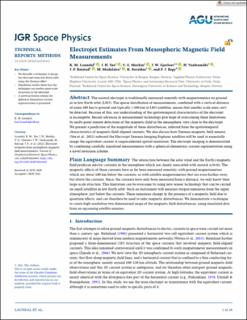| dc.contributor.author | Laundal, Karl Magnus | |
| dc.contributor.author | Yee, J.H. | |
| dc.contributor.author | Merkin, V.G. | |
| dc.contributor.author | Gjerløv, Jesper | |
| dc.contributor.author | Vanhamäki, H. | |
| dc.contributor.author | Reistad, Jone Peter | |
| dc.contributor.author | Madelaire, Michael | |
| dc.contributor.author | Sorathia, K. | |
| dc.contributor.author | Espy, Patrick Joseph | |
| dc.date.accessioned | 2022-02-18T08:09:39Z | |
| dc.date.available | 2022-02-18T08:09:39Z | |
| dc.date.created | 2021-07-15T17:00:43Z | |
| dc.date.issued | 2021 | |
| dc.identifier.issn | 2169-9380 | |
| dc.identifier.uri | https://hdl.handle.net/11250/2979893 | |
| dc.description.abstract | The auroral electrojet is traditionally measured remotely with magnetometers on ground or in low Earth orbit (LEO). The sparse distribution of measurements, combined with a vertical distance of some 100 km to ground and typically >300 km to LEO satellites, means that smaller scale sizes can't be detected. Because of this, our understanding of the spatiotemporal characteristics of the electrojet is incomplete. Recent advances in measurement technology give hope of overcoming these limitations by multi-point remote detections of the magnetic field in the mesosphere, very close to the electrojet. We present a prediction of the magnitude of these disturbances, inferred from the spatiotemporal characteristics of magnetic field-aligned currents. We also discuss how Zeeman magnetic field sensors (Yee et al., 2021) onboard the Electrojet Zeeman Imaging Explorer satellites will be used to essentially image the equivalent current at unprecedented spatial resolution. The electrojet imaging is demonstrated by combining carefully simulated measurements with a spherical elementary current representation using a novel inversion scheme. | en_US |
| dc.language.iso | eng | en_US |
| dc.publisher | Wiley | en_US |
| dc.rights | Navngivelse 4.0 Internasjonal | * |
| dc.rights.uri | http://creativecommons.org/licenses/by/4.0/deed.no | * |
| dc.title | Electrojet Estimates From Mesospheric Magnetic Field Measurements | en_US |
| dc.type | Journal article | en_US |
| dc.type | Peer reviewed | en_US |
| dc.description.version | publishedVersion | en_US |
| dc.rights.holder | Copyright 2021. The Authors | en_US |
| dc.source.articlenumber | e2020JA028644 | en_US |
| cristin.ispublished | true | |
| cristin.fulltext | original | |
| cristin.qualitycode | 2 | |
| dc.identifier.doi | 10.1029/2020JA028644 | |
| dc.identifier.cristin | 1921898 | |
| dc.source.journal | Journal of Geophysical Research (JGR): Space Physics | en_US |
| dc.identifier.citation | Journal of Geophysical Research: Space Physics. 2021, 126 (5), e2020JA028644. | en_US |
| dc.source.volume | 126 | en_US |
| dc.source.issue | 5 | en_US |

